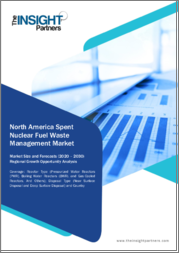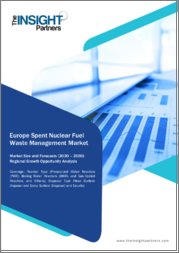
|
시장보고서
상품코드
1725927
토륨 시장 : 현황 분석 및 예측(2024-2032년)Thorium Market: Current Analysis and Forecast (2024-2032) |
||||||
원자력 사업에서는 우라늄보다 방사성 폐기물 발생이 적고 안전성이 높은 토륨이 효율이 높다는 이유로 선호되고 있습니다. 첨단 원자로 기술에는 토륨이 필요하며, 토륨은 주로 모나자이트 광상, 카보나이트 지층, 알칼리성 암석 등 세 가지 장소에서 추출됩니다. 원자력에서 토륨의 시장 개척이 활발히 진행되고 있는 것은 친환경 원자력발전을 필요로 하는 국가가 늘어나는 한편, 대량의 토륨을 보유하고 있고, MSR 기술도 향상되고 있기 때문입니다. 희토류 원소(REE)의 추출을 돕는 토륨의 능력은 REE가 친환경 에너지 기술 및 현대 기술 분야에서 중요한 기능을 수행하기 때문에 잠재적인 시장 기회를 더욱 창출합니다.
토륨 시장 규모는 보다 안전하고 지속가능한 원자력 에너지에 대한 수요 증가와 용융염로 기술의 발전으로 인해 예측 기간 동안 연평균 6.7%의 견조한 성장세를 보일 것으로 예상됩니다. 인도와 중국이 주요 토륨 시장으로 성장할 것으로 예상되는 이유는 이들 국가가 상당한 토륨 매장량을 보유하고 있고 원자력 확장을 계획하고 있기 때문입니다. 인도는 3단계 원자력 계획을 통해 장기적인 에너지 계획으로 토륨 원자로를 지속적으로 추진해 왔습니다. 인도는 2021년 MSR 기술의 프로토타입 성공 이후 세계 최고의 토륨 원자력 개발국이 되었습니다.
유형별로 시장은 플레이서, 카보나이트, 알칼리성 암석 및 기타로 분류됩니다. 이 중 플레이서-트리움 시장은 큰 CAGR로 성장하고 있습니다. 플레이서-트리움 시장이 성장하는 이유는 모나자이트가 포함된 중광물 모래에 토륨 생산에 필요한 주요 원료가 포함되어 있기 때문입니다. 인도, 호주, 브라질은 연안부의 광상을 잘 활용하여 원자력 에너지 생산에 기여하고 있으며, 첨단 소재 개발을 위해서는 더 많은 공급이 필요합니다. 광상은 단단한 암석을 채굴하는 것보다 더 쉽게 토륨을 공급할 수 있는 경제적이고 쉬운 방법을 기업에게 제공합니다. 토륨 프로젝트는 환경 채굴 기준과 토륨 발견을 지원하는 정부 프로그램에 의해 탄력을 받고 있습니다.
용도별로 토륨 시장은 원자력, 항공우주 및 방위, 의료용, 산업용으로 구분됩니다. 원자력 에너지 분야는 예측 기간 동안 큰 CAGR을 기록했습니다. 청정에너지 창출에 대한 전 세계적인 요구가 토륨 시장에서 원자력발전 사업의 성장을 촉진하고 있습니다. 정부 지도자들과 에너지 기업들은 기후 변화에 대한 우려가 커지면서 새로운 연료 옵션을 찾고 있으며, 토륨은 화석 연료를 대체할 수 있는 효과적인 대안으로 각광받고 있습니다. 토륨으로 강화된 MSR은 핵무기 개발 가능성을 낮추는 동시에 오염이 적은 방사성 폐기물을 생성합니다. 세계에는 많은 토륨이 있으며, 이 연료는 낮은 운영 비용으로 원자력발전소를 효율적으로 운영할 수 있습니다. 인도, 중국, 미국 등 주요 국가들은 토륨 원자로 연구 프로젝트에 막대한 자금을 투입하여 시장 개척에 박차를 가하고 있습니다.
토륨 산업의 시장 도입을 더 잘 이해하기 위해 시장은 북미(미국, 캐나다, 기타 북미), 유럽(독일, 영국, 프랑스, 스페인, 이탈리아, 기타), 아시아태평양(중국, 일본, 인도, 호주, 기타), 기타 지역의 세계 존재를 기반으로 분석됩니다. 아시아태평양 국가들은 원자력 개발에 자금을 투자하고 녹색 에너지 시스템을 지지하기 때문에 이 분야에 참여하는 국가들이 증가하고 있습니다. 아시아태평양 국가들이 원자로에서 토륨을 가장 많이 사용하는 이유는 이들 발전소가 우라늄 연소 원자로보다 더 나은 안전성과 장기적인 전력 공급을 제공하기 때문입니다. 인도는 세계에서 가장 많은 토륨 광상을 보유하고 있어 토륨 기반 원자로의 연구개발을 주도하고 있습니다. 인도 정부는 우라늄을 수입하는 대신 자체 생산을 통해 토륨 기반 에너지를 생산하기 위한 명확한 조치를 취했습니다. 중국은 탄소 중립 목표를 달성하기 위해 용융염로 시설을 가동하여 토륨 원자로 개발을 추진하고 있습니다. 일본은 에너지 개발 시스템을 계획하는 한편, 토륨 연구를 원자력 에너지에 활용하고 있습니다. 국제적인 토륨 공급국인 호주는 미래의 원자력발전을 위해 이 천연 연료의 과학적 가치를 연구하고 있습니다. 아시아태평양 국가들은 더 나은 에너지 안보와 핵폐기물 및 탄소 배출에 대한 해결책이 필요하기 때문에 대체 핵연료에 대한 투자를 계속하고 있습니다. 토륨 원자로 프로젝트는 여러 지역 정부가 원자력 연구센터와 민간 원자력 사업자와 협력하면서 구체화되었습니다. 아시아태평양의 각국 정부는 원자력발전의 급속한 지역적 확장을 촉진하기 위해 연구 및 생산 노력을 지원함으로써 원자력발전을 지속적으로 지원하고 있습니다.
이 시장에서 사업을 운영하는 주요 기업으로는 American Rare Earths Limited, Cameco Corporation, China National Nuclear Corporation, Flibe Energy, Centrus Energy Corporation, Skyharbour Resources Limited, Copenhagen Atomics, Clean Core Thorium Energy, Inc., Indian Rare Earths Limited, TerraPower 등이 있습니다.
세계의 토륨 시장에 대해 조사했으며, 시장 개요, 유형별·용도별·지역별 동향, 시장 진입 기업 프로파일 등의 정보를 전해드립니다.
목차
제1장 시장 소개
제2장 조사 방법 또는 가정
제3장 주요 요약
제4장 시장 역학
- 성장 촉진요인
- 기회
- 성장 억제요인
- 동향
- PESTEL 분석
- 수요측 분석
- 공급측 분석
제5장 가격 분석
- 지역 가격 분석
- 가격에 영향을 미치는 요인
제6장 세계의 토륨 시장 매출(100만 달러), 2022-2032년 예측
제7장 유형별 시장 분석
- 광상
- 탄산염암
- 알칼리암
- 기타
제8장 용도별 시장 분석
- 원자력 에너지
- 항공우주 및 방위
- 의료
- 산업
제9장 지역별 시장 분석
- 북미
- 미국
- 캐나다
- 기타
- 유럽
- 독일
- 영국
- 스페인
- 프랑스
- 이탈리아
- 기타
- 아시아태평양
- 중국
- 인도
- 일본
- 호주
- 기타
- 기타 국가
제10장 밸류체인 분석
- 한계 분석
- 시장 진입 기업 리스트
제11장 경쟁 구도
- 경쟁 대시보드
- 경쟁 시장 포지셔닝 분석
- Porter’s Five Forces 분석
제12장 기업 개요
- American Rare Earths Limited
- Cameco Corporation
- China National Nuclear Corporation
- Flibe Energy
- Centrus Energy Corporation
- Skyharbour Resources Limited
- Copenhagen Atomics
- Clean Core Thorium Energy, Inc.
- Indian Rare Earths Limited
- TerraPower
제13장 두문자어와 가정
제14장 부록
ksm 25.06.02The nuclear energy business favors thorium due to its higher efficiency while creating less radioactive waste and providing better safety than uranium. Advanced reactor technologies need thorium, which is extracted mainly from three types of sites: monazite placer deposits, carbonatite formations, and alkaline rocks. The market for thorium in nuclear energy is developing because more nations require environmentally friendly nuclear power sources while possessing large thorium supplies, plus MSR technology boosts. The ability of thorium to help extract rare earth elements (REE) creates more potential market opportunities since REEs serve important functions in green energy technology and modern technology fields.
The Thorium Market is expected to grow at a robust CAGR of 6.7% during the forecast period, owing to the rising demand for safer, sustainable nuclear energy and advancements in molten salt reactor technology. India and China will grow as major thorium markets because these countries have significant thorium deposits and plans for nuclear expansion. Through its three-stage nuclear program, India has always promoted thorium nuclear reactors as a long-term energy plan. The nation became the leading global thorium nuclear developer after achieving MSR technology success with its prototype in 2021.
Based on Type, the market is categorized into Placer, Carbonatite, Alkaline Rocks, and Others. Among these, Placer Thorium market is growing with a significant CAGR. The Placer thorium market grows because heavy mineral sands with monazite contain the primary raw material needed for thorium production. India, Australia, and Brazil make good use of their coastland deposits to help supply nuclear energy production, with more supply needed for advanced materials development. Placer deposits provide companies with an economical and straightforward way to gain thorium supply more easily than hard rock mining operations. Thorium projects gain momentum from environmental mining standards, plus government programs that support discovering thorium.
Based on Application, the Thorium market is divided into Nuclear Energy, Aerospace & Defense, Medical Applications, and Industrial Use. The Nuclear Energy segment registered a significant CAGR during the forecast period. The worldwide need for clean energy creation drives the growth of nuclear power operations in the thorium market. Government leaders and energy firms want new fuel options because of rising climate fears, so thorium stands out as an effective replacement for fossil fuels. MSRs enhanced by thorium produce less pollution-friendly radioactive waste while decreasing the possibility of developing nuclear weapons. The world has much thorium available, and this fuel can run nuclear power plants at increased efficiency at low running costs. Several major nations, such as India, China, and the United States, put substantial money into thorium reactor research projects, which boosts market development.
For a better understanding of the market adoption of the Thorium industry, the market is analyzed based on its worldwide presence in countries such as North America (U.S.A., Canada, and Rest of North America), Europe (Germany, United Kingdom, France, Spain, Italy, and Rest of Europe), Asia-Pacific (China, Japan, India, Australia, and Rest of Asia-Pacific), Rest of World. More Asian-Pacific nations are joining this sector because they put money into nuclear power developments and support green energy systems. Pacific Asian nations are top users of thorium in nuclear reactors because these power plants deliver better safety and long-term power than uranium-burning reactors. Since India holds the most global thorium deposits, it leads research and development for thorium-based reactors. The Indian administration created distinct actions to produce thorium-based energy through home production instead of importing uranium. China moves thorium reactor development forward by running molten salt reactor facilities to reach its carbon neutrality goals. Japan uses thorium research to power nuclear energy while planning its energy development system. As an international supplier of thorium, Australia studies the scientific value of this natural fuel for future nuclear power production. Countries in APAC continue to invest in nuclear fuel alternatives because they need better energy security and solutions for nuclear waste plus carbon emissions. Thorium reactor projects have taken shape since multiple regional governments now partner nuclear research centers with private nuclear businesses. Governments in APAC continuously support nuclear power by backing research and production efforts to fuel its fast regional expansion.
Some of the major players operating in the market include American Rare Earths Limited, Cameco Corporation, China National Nuclear Corporation, Flibe Energy, Centrus Energy Corporation, Skyharbour Resources Limited, Copenhagen Atomics, Clean Core Thorium Energy, Inc., Indian Rare Earths Limited, and TerraPower.
TABLE OF CONTENTS
1.Market Introduction
- 1.1. Market Definitions
- 1.2. Main Objective
- 1.3. Stakeholders
- 1.4. Limitation
2.Research Methodology Or Assumption
- 2.1. Research Process of the Thorium Market
- 2.2. Research Methodology of the Thorium Market
- 2.3. Respondent Profile
3.Executive Summary
- 3.1. Industry Synopsis
- 3.2. Segmental Outlook
- 3.2.1. Market Growth Intensity
- 3.3. Regional Outlook
4.Market Dynamics
- 4.1. Drivers
- 4.2. Opportunity
- 4.3. Restraints
- 4.4. Trends
- 4.5. PESTEL Analysis
- 4.6. Demand Side Analysis
- 4.7. Supply Side Analysis
- 4.7.1. Merger & Acquisition
- 4.7.2. Investment Scenario
- 4.7.3. Industry Insights: Leading Startups and Their Unique Strategies
5.Pricing Analysis
- 5.1. Regional Pricing Analysis
- 5.2. Price Influencing Factors
6.Global Thorium Market Revenue (USD Mn), 2022-2032F
7.Market Insights By Type
- 7.1. Placer
- 7.2. Carbonatite
- 7.3. Alkaline Rocks
- 7.4. Others
8.Market Insights By Application
- 8.1. Nuclear Energy
- 8.2. Aerospace & Defense
- 8.3. Medical Applications
- 8.4. Industrial Use
9.Market Insights By Region
- 9.1. North America
- 9.1.1. USA
- 9.1.2. Canada
- 9.1.3. Rest of NA
- 9.2. Europe
- 9.2.1. Germany
- 9.2.2. United Kingdom
- 9.2.3. Spain
- 9.2.4. France
- 9.2.5. Italy
- 9.2.6. Rest of Europe
- 9.3. Asia Pacific
- 9.3.1. China
- 9.3.2. India
- 9.3.3. Japan
- 9.3.4. Australia
- 9.3.5. Rest of APAC
- 9.4. Rest of World
10.Value Chain Analysis
- 10.1. Marginal Analysis
- 10.2. List of Market Participants
11.Competitive Landscape
- 11.1. Competition Dashboard
- 11.2. Competitor Market Positioning Analysis
- 11.3. Porter Five Forces Analysis
12.Company Profiled
- 12.1. American Rare Earths Limited
- 12.1.1. Company Overview
- 12.1.2. Key Financials
- 12.1.3. SWOT Analysis
- 12.1.4. Product Portfolio
- 12.1.5. Recent Developments
- 12.2. Cameco Corporation
- 12.3. China National Nuclear Corporation
- 12.4. Flibe Energy
- 12.5. Centrus Energy Corporation
- 12.6. Skyharbour Resources Limited
- 12.7. Copenhagen Atomics
- 12.8. Clean Core Thorium Energy, Inc.
- 12.9. Indian Rare Earths Limited
- 12.10. TerraPower


















